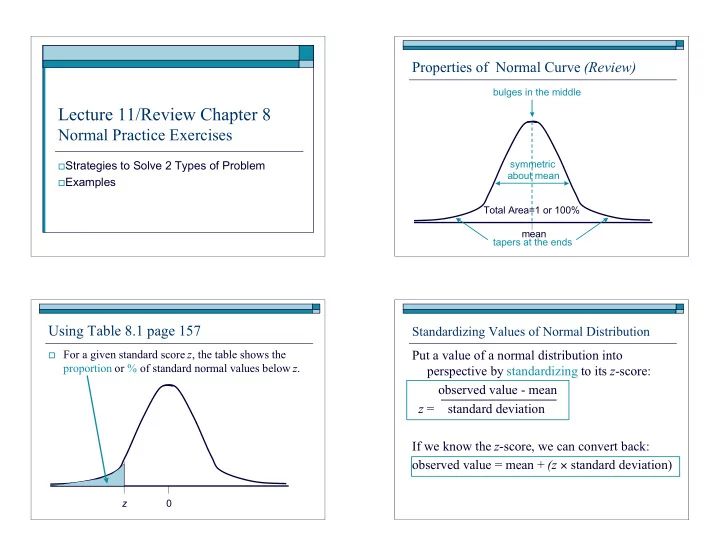

Properties of Normal Curve (Review) bulges in the middle Lecture 11/Review Chapter 8 Normal Practice Exercises symmetric � Strategies to Solve 2 Types of Problem about mean � Examples Total Area=1 or 100% mean tapers at the ends Using Table 8.1 page 157 Standardizing Values of Normal Distribution � For a given standard score z , the table shows the Put a value of a normal distribution into proportion or % of standard normal values below z . perspective by standardizing to its z -score: observed value - mean z = standard deviation If we know the z -score, we can convert back: observed value = mean + (z � standard deviation) z 0
Example: Normal Exercise #1A Strategies for 2 Types of Problem A. Given normal value, find proportion or %: � Background : Scores x have mean 100 pts, sd 10 pts. � Calculate z =(observed-mean)/sd [sign + or -?] � Question: What % are below 115 pts? � Response: � Look up proportion in Table [adjust if asked for proportion above or between, not below ] Table � B. Given proportion or %, find normal value: Answer: _____% are below 115 pts. � [adjust if asked for proportion above or ? between ] Locate proportion in Table, find z . � Unstandardize: observed = mean + ( z � sd) SKETCH! We’ll assume all examples today follow a normal curve... x z 100 115 0 Example: Normal Exercise #1B Example: Normal Exercise #2A � Background : Scores x have mean 100 pts, sd 10 pts. � Background : Sizes x have mean 6 inches, sd 1.5 inch. � Question: The lowest 84% are below how many pts? � Question: What % are below 5 inches? � Response: Table � � Response: Unstandardize to x = Table � Answer: The lowest 84% are below _____ pts. Answer: _____% are below 5 inches. 0.84 0.84 ? z x x z 0 100 ?= 0 5 6
Example: Normal Exercise #2B Example: Normal Exercise #3A � Background : Sizes x have mean 6 inches, sd 1.5 inch. � Background : No. of cigarettes x has mean 20, sd 6. � Question: The tallest 1% are above how many inches? � Question: What % are more than 23 cigarettes? � Response: 0.01 above �� � Response: z = Unstandardize to Table � Answer: The tallest 1% are above_____ inches. Answer: ___% are more than 23 cigarettes. ?= ? 0.01 0.01 z x x z 0 6 20 23 0 ?= Example: Normal Exercise #3B Example: Normal Exercise #4A � Background : No. of cigarettes x has mean 20, sd 6. � Background : Wts x have mean 165 lbs, sd 12 lbs. � Question: 90% are more than how many cigs? � Question: What % are more than 141 lbs? � Response: � Response: z = Table � Answer: 90% are above ______ cigarettes. Answer: _____% are more than 141 lbs. ? z x x z 0 0 141 165
Example: Normal Exercise #4B Example: Normal Exercise #5 � Background :Weights x have mean 165 lbs, sd 12 lbs. � Background : No. of people x has mean 4, sd 1.3. � Question: The lightest 2% are below how many lbs? � Question: What % of the time is x between 2 and 6? � Response: � Response: Answer: The lightest 2% are below ______ lbs. z x 0 Example: Normal Exercise #6 Example: Normal Exercise #7 � Background : Duration x has mean 11 years, sd 2 years. � Background : Earnings x have mean $30K, sd $8K. � Question: What % of the time is x between 14 and 17? � Question: What % of the time is x bet. $20K and $22K? � Response: � Response:
Example: Normal Exercise #8 “Off the Chart” For extreme negative z values, proportion below � Background : Amts. x have mean 300 ml, sd 3 ml. is approx. 0, proportion above is approx. 1. � Question: What % of the time is x …? (a) <280 ml (b) > 280 ml (c) < 315 ml (d) >315 ml For extreme positive z values, proportion below � Response: is approx. 1, proportion above is approx. 0. (a) (b) (c) (d) Example: Normal Exercise #9 Empirical Rule (Review) � Background : Consider Examples 1(b), 4(a). For any normal curve, approximately � Question: What does Empirical Rule tell us? � 68% of values are within 1 sd of mean � Response: � 95% of values are within 2 sds of mean 1(b) mean=100, sd=10. � 99.7% of values are within 3 sds of mean 4(a) mean=165, sd=12.
Recommend
More recommend